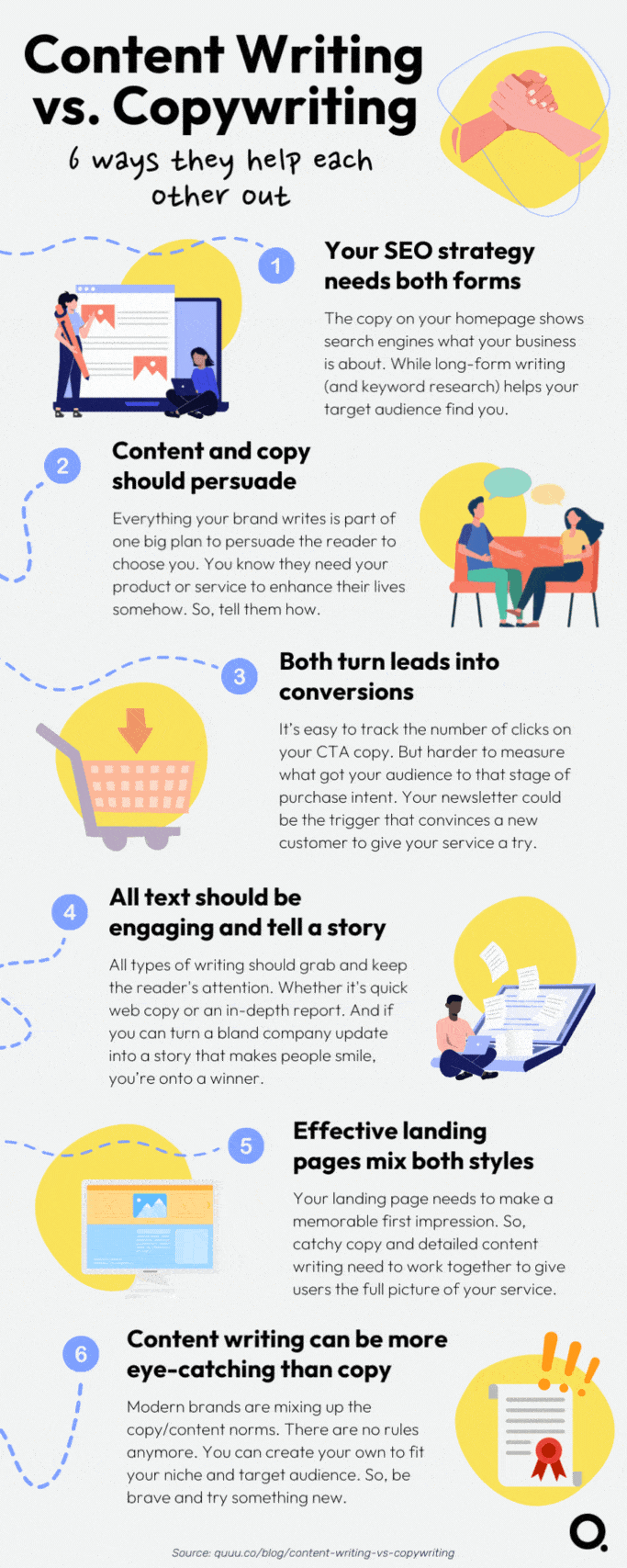Everyone wants to point out the differences in the content writing vs. copywriting argument. Apparently, one’s short-form ads for selling. The other is long-form articles for education. Copy converts. Content writing drives traffic.
But there are too many overlaps for them to be separate. And the overarching goal of marketing is to get that sale. Sure, you might specialize as a content writer or copywriter. But the two are working together for the same outcome.
So, let’s not focus on their differences. Let’s focus on what they have in common. Here are 6 ways content writing and copywriting help each other out:
- Your SEO strategy needs long-form and short-form content
- Both are meant to persuade the reader to take action
- Content writing and copy turn leads into conversions
- All text should be engaging and read like a story
- Effective landing pages mix both styles
- Content writing can be more eye-catching than copy

Your SEO strategy needs long-form and short-form content
Every company’s content marketing strategy has a different goal:
- Blog posts can set up long-term lead generation
- Social media posts are great for brand awareness
- Email marketing campaigns can help with customer retention and loyalty
But one of the most popular goals of content writing and copywriting is SEO (search engine optimization). And both have their part to play.
The headline copy on your landing page shows search engines what your business is about. While long-form content writing (with keyword research) helps your target audience find you. Done right, it can increase organic traffic too.
Your SEO content can come in many forms:
| Short-form content | Long-form content |
| Call to action (CTA) | How-to guide |
| Slogan/tagline | White paper |
| Landing page headline | eBook |
| Sales copy (product info) | Case study |
| PPC ads | Podcast and video scripts |
Even visual types of content can benefit by including copy alongside it. Writing up the transcript for a video or including a blog post with an infographic can help your rankings. Because you’re including the keywords and phrases your audience is (hopefully) searching for.
Including keywords in your content and copy is so important. Because that tells search engines how relevant your page is to your niche. But what’s more important is making your human readers a priority.
Everything you write needs to be clear and easy to read. That’s why conversational copy is so effective.

This uses tactics like:
- Using personal pronouns like “you” and “your”
- Matching their tone
- Keeping it informal
- Simplify your language (don’t try too hard)
It’s more than possible to keep both your audience and search engines happy. Google’s main goal is to satisfy user search intent. So, use SEO-focused keywords to help your target audience find you. But give them a human-first experience when they get there.
Both are meant to persuade the reader to take action
The typical content writing vs. copywriting argument is this:
- Content should inform
- Copy should persuade
But the whole point of digital marketing is to increase awareness of your brand. And make sure people have a positive perception of it (so they buy or sign up.)
Everything you “say” online feeds into your brand identity. And this personality is how your target audience will relate to you. Because people want to buy from businesses with the same values as them.
So, your copy and content shouldn’t talk about how great your product or service is. It should talk about how you’re going to fit into your customer’s life. And how you’ll improve it.

Like Marketing Examples’ Harry Dry says:
“People don’t want a better toothbrush. They want a brighter smile.”
Creating content that persuades people to take action comes from knowing your audience. If you know what keywords and terms they’re searching for, you can:
- Update your site and ad copy to match
- Create valuable content that answers questions
Great content should be persuasive. Your headline should persuade people to read the introduction. The intro should persuade people to read the main body. You get the picture.
Everything your brand writes is all part of one big plan to persuade the reader to choose you. You’re trying to convince your target audience to feel the same as you. They need your product or service to enhance their lives in some way. And you’re going to tell them how.

If you’re an eCommerce business, you might want to create a sense of urgency with your copy. But people need to know more about potential purchases. So, product descriptions give more detail.
So, are product descriptions content writing? (Because they educate.) But hold up…aren’t they a form of marketing copy too? Because they persuade you to buy?

Clearly, it’s not that simple. Copy shouldn’t just “persuade” and content “inform”. Both should try to do both.
Content writing and copy turn leads into conversions
Website copy is meant to encourage users to take action. Whether that’s to purchase, download, or sign up. And your choice of words can directly impact conversion rates.
But good content does this too. Sure, it might be for education rather than direct selling. But conversions are still the goal.
It’s easy to track the number of clicks on your CTA copy. But harder to measure what got your audience to that stage. Your high-quality email newsletter could be the thing that convinces a new customer to give your service a try.
Content creation comes in many forms. And each piece of content (or copy) will target users at different stages of the funnel.

For example:
- Ads and social posts create brand awareness for strangers
- Valuable content can turn prospects into leads
- Trials and demos can close deals and create new customers
Some might be ready to purchase as soon as they land on your site. While others may have never heard of your brand or product before. So, different types of content and copy on landing pages help filter them down the funnel.
That’s why both your content and copy sell. And the more indirect you can be, the better. No one responds well to “Buy our product right now!” You need to help make them feel like it’s their decision.

This is why a unique brand voice is important too. All business owners and bloggers in your niche want the same money or subscriptions from the same group of people. So, you have to stand out somehow.
If you know your audience, you understand how they speak. Then you can use that data to create your brand voice. And “speak” to them in a way that resonates.
Both forms should be engaging and read like a story
Copyblogger founder Brian Clark said it best:
Engaging copy grabs people’s attention. But then you need to hold it. And the best way to do that is through storytelling.
The human brain has around 2,000 daydreams a day. When someone tells an interesting story, this mental wandering stops. Stories also connect listeners or readers to the storyteller emotionally. And emotionally-engaged customers are:
- 3x more likely to recommend you to others
- 3x more likely to repurchase
- Less price sensitive
- Less likely to shop around
So, we know the most effective content marketing tells a story. But a couple lines of marketing copy can do that too.
Here’s the landing page headline for Lemon. Lemon helps startups find freelance developers to work with. And it’s a perfect example of copywriting that tells a story.
“Behold! The almighty devs you’ve been searching for”.

This headline sounds like the start of a Monty Python sketch, right?

Lemon have mastered the art of storytelling through copy. The “About” webpage of a site is usually incredibly dull. But not this one:

Tell me that doesn’t educate you about their service in an engaging, memorable way.
Even your sales emails can do the same. Watch how CRED turns an update about app bug fixes into a comical letter:

All types of writing should grab and keep readers’ attention. Whether it’s quick web copy or an in-depth report. And if you can turn a bland company update into a short story that makes people smile, you’re onto a winner.
Effective landing pages mix content and copy
We all want a memorable headline on our site. But don’t fall into the trap of trying to be too poetic. If your copy doesn’t immediately tell people what you’re offering, it’s too vague.
You might think it sounds cool. But you only get a few seconds to make a great first impression. So, use them wisely.

LearnWorlds is a great example of how to do it right. Their main copy sums up the service in one line: “Create and sell online courses from your own website”.

Now, yes. That sounds great. But I doubt you’re sold yet. So, the next section of content writing tells you more.

BarkBox is another example of clear, well-formatted copy. Here’s the main summary: “Give your dog exactly what they want. A totally customized box of themed toys and treats for your pup—every month”.

As a dog owner, I think, “Sweet!” But then wonder how it all actually works. So, a bit of content writing below details the service.

For more complex industries, you’ll need to explain the process in more detail. Modern Fertility shows how to mix copy and content to give new visitors trust in your service.
“Want kids one day?” hooks the target audience. People who are hoping to start a family one day.

But the products aren’t cheap. And fertility is a complicated subject. So, big sections of educational content writing underneath explains the benefits and process.

You want to try “show, not tell” as much as possible. But sometimes, there’s no substitute for great writing. So, make sure to use lots of graphics and color on your landing pages. But let your copy and content work together to get your message across.
Content writing can be more eye-catching than short copy
Copywriters might be better with catchy slogans. If that’s your skillset, more power to you.

This traditional advertising method is still so effective. And for good reason. As consumers, we’re hit with a torrent of content from the moment we wake up. Some we search for, others we don’t.
It used to be sales letters and direct mail. Now, open the paper? Ads. Drive to work? Billboards. Scroll through social media content? Sponsored ads. But users that see these ads may not be quite ready to buy. And potential customers need time to think if you’re asking for a lot of money or offering a complex service.
Yes, you need to catch their attention. But today’s consumers don’t take everything at face value anymore. They want to research a company before buying from them or signing up. Your brand values have never been more important. And you get those across through content writing.
Examples of eye-catching content writing
So, what are some examples of content writing that can be more eye-catching than copy?
Kiwi Shoe Polish featured the real shoes of a few famous folks in their 2018 print ads. And they chose to use long-form writing under their main copy to give a detailed narrative. You might think it’s a weird choice but it was super successful.
Why? Because it tells a story. Muhammad Ali’s version “highlights the magic of the man and makes the case that his shoes were part of what made him a champion of the world.”

Alternative milk brand Oatly uses this technique too. The company has a lot to say. Especially about health and sustainability. But when they started out, they had barely any media budget. So, they created a unique marketing strategy using long-form writing.
A lot of brands go for the minimalist look with their packaging. But Oatly decided to use theirs as their main marketing channel. A.K.A “packvertising”.

Because it’s so different from every other milk carton out there, it draws your attention. The wall of text does the opposite of what you’d think. It actually makes you want to find out what it’s saying.
Modern brands are mixing up the copy/content norms these days. There are no rules anymore. You can create your own to fit your niche and target audience. So, why not be brave and try something new?
Conclusion
If you have writing skills, you have the potential to be a great copywriter or content writer. Because both styles have their purpose for the same goal. And you should be thinking about how they can fit into your content strategy.
Sure, a catchy headline can keep people on your landing page. But your in-depth blogs and vibrant infographics are what your target audience shares on social media.
It isn’t as simple as copy persuades and content educates. You should be getting your product’s value and USP across at every opportunity. Not just clearly but memorably. And in an engaging way that grabs and holds people’s attention.
So, don’t try to separate your content and copy. Figure out how they can work better together.
What’s your take on the content writing vs. copywriting argument? Do you have any additional points we should add? Let us know in the comments below.





